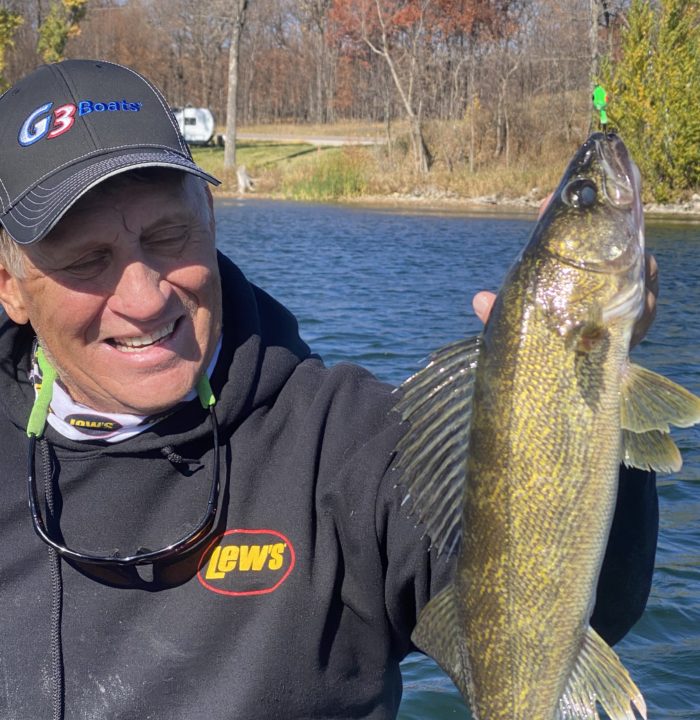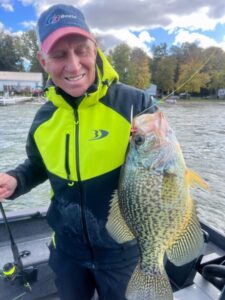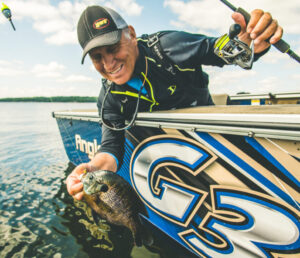Of Jigs and Walleyes
By Mike Frisch
Early season walleye fishing in most rivers, reservoirs, and lakes in the Midwest often involves the use of a jig/minnow combination. Here’s a look at some important factors that I’ve learned about jigs, minnows, and walleyes and how they sometimes go together!
The first consideration when choosing a jig for many is jig color. Before color becomes a factor, however, I believe jig size is important. When pitching a jig/minnow to shallow water during spring, maybe a rocky shoreline in 2 to 3 feet or a sand flat in 5 to 7 foot of water, a 1/16 ounce size jig is usually best. If, however, the water is a bit deeper or the wind kicks up, a 1/8-ounce size may be better. For me, I like to fish the smallest weight I can while still retaining good “feel” of the jig and bottom since spring walleyes are often located close to bottom. Light jigs often work well for lake anglers, while river “rats” who encounter current may need to use bigger ¼ and 3/8 jigs to maintain bottom contact and feel.
Now let’s consider color. For me, color only matters if I have the right jig size AND, most importantly, put it around walleyes! Many anglers would be more successful if they paid greater attention to finding feeding walleyes than what the best color jig is. Nevertheless, color can be very important. I still favor the mantra that “dark, dingy water means a bright jig and clear water means more natural or metallic patterns.” Above all, I think having each angler in the boat try a different color and letting the fish “decide” what they want is good.
Jig choice is of obvious importance and so is choosing the right fishing line and rod/reel combination for use with it. A 6 to 7 foot medium light power, extra fast action spinning rod loaded with 6 or 8 pound fluorocarbon line is a typical walleye jigging rod. If vertical fishing in a river in somewhat deeper water is on your agenda, a shorter rod with 8 pound line might be best. If you fish natural lakes and spend more time pitching, a bit longer rod with 6 pound line might be better. For me, the 6’7” “walleye jigging” model in the Lew’s Speed Stick series paired with a spinning reel loaded with 8 pound fluorocarbon is a good all-around choice. This combination keeps me more than adequately prepared for most any spring walleye situation encountered. Plus, not only is this a quality, sensitive jigging “stick” but it’s also very affordable, meaning I can have several rods with various sized jigs ready to fish differing depths, or for when experimenting with jig colors.
Now that we’re adequately equipped, let’s talk jigging techniques. When fishing deeper waters and river current, trying to keep your line vertical and popping or snapping the jig up and down might be best. When pitching to shallow rubble or sand on lakes, however, a slow lift/drop/pause retrieve may work well. If the fish are a bit deeper, say holding on a flat in 7 feet of water, casting the jig out behind the boat and slowly swimming it while drifting with the wind often works well.
The jigging techniques just described are all good “starting” methods for those particular situations. But experimenting with the particulars within a jig presentation or retrieve will probably be needed to dial in what the walleyes really want on a particular fishing day.
For example, on a spring day many years ago I got out-fished by an angler throwing the same jig on the same rod/reel/line setup to the same shoreline! My fishing partner caught a bunch of chunky 16 to 19 inch walleyes while I caught two. The difference, I later learned, was that while I was letting my jig settle to bottom and lifting/dropping, he was using a slow, but steady swimming retrieve. Lesson learned! By the way, I’m less stubborn and a lot more observant of my angling partners today, particularly those catching fish.
If catching walleyes is on your spring agenda, a jig and minnow combination will probably be in your hands at some point. The above thoughts regarding jigs, minnows, and spring walleyes are for your consideration in hopes that using some of them might just add to your catch. Good luck on the water and, as always, remember to include a youngster in your next fishing trip!





